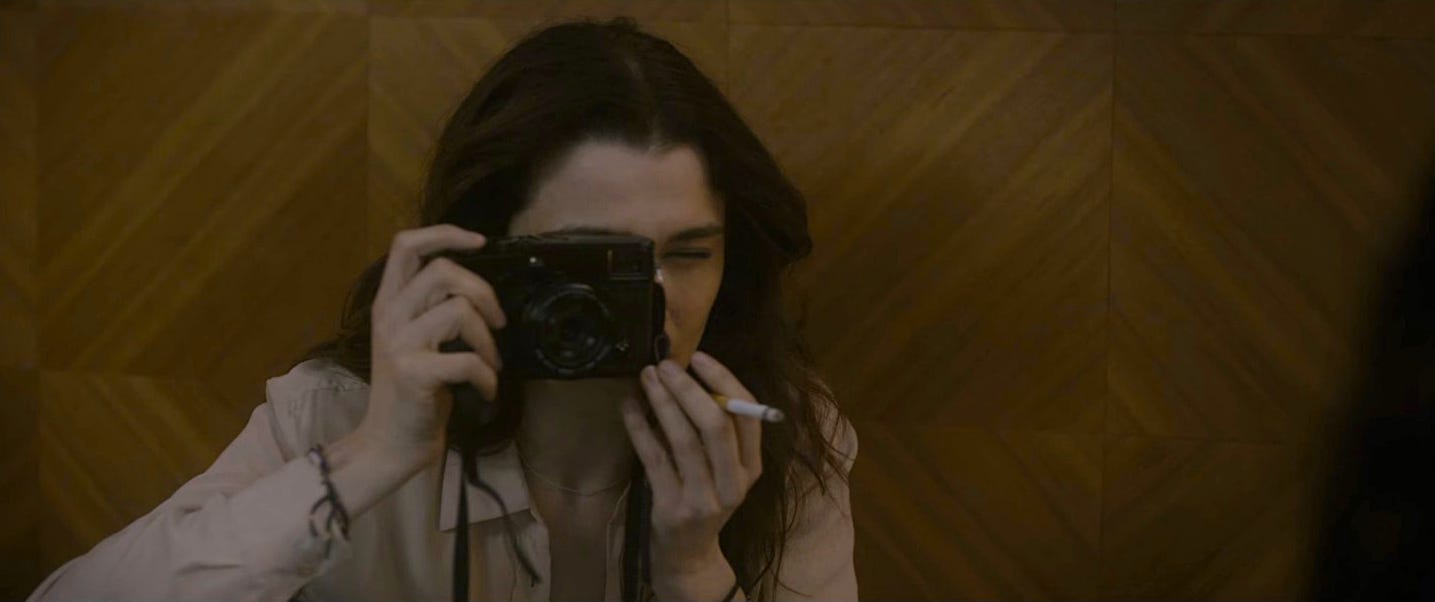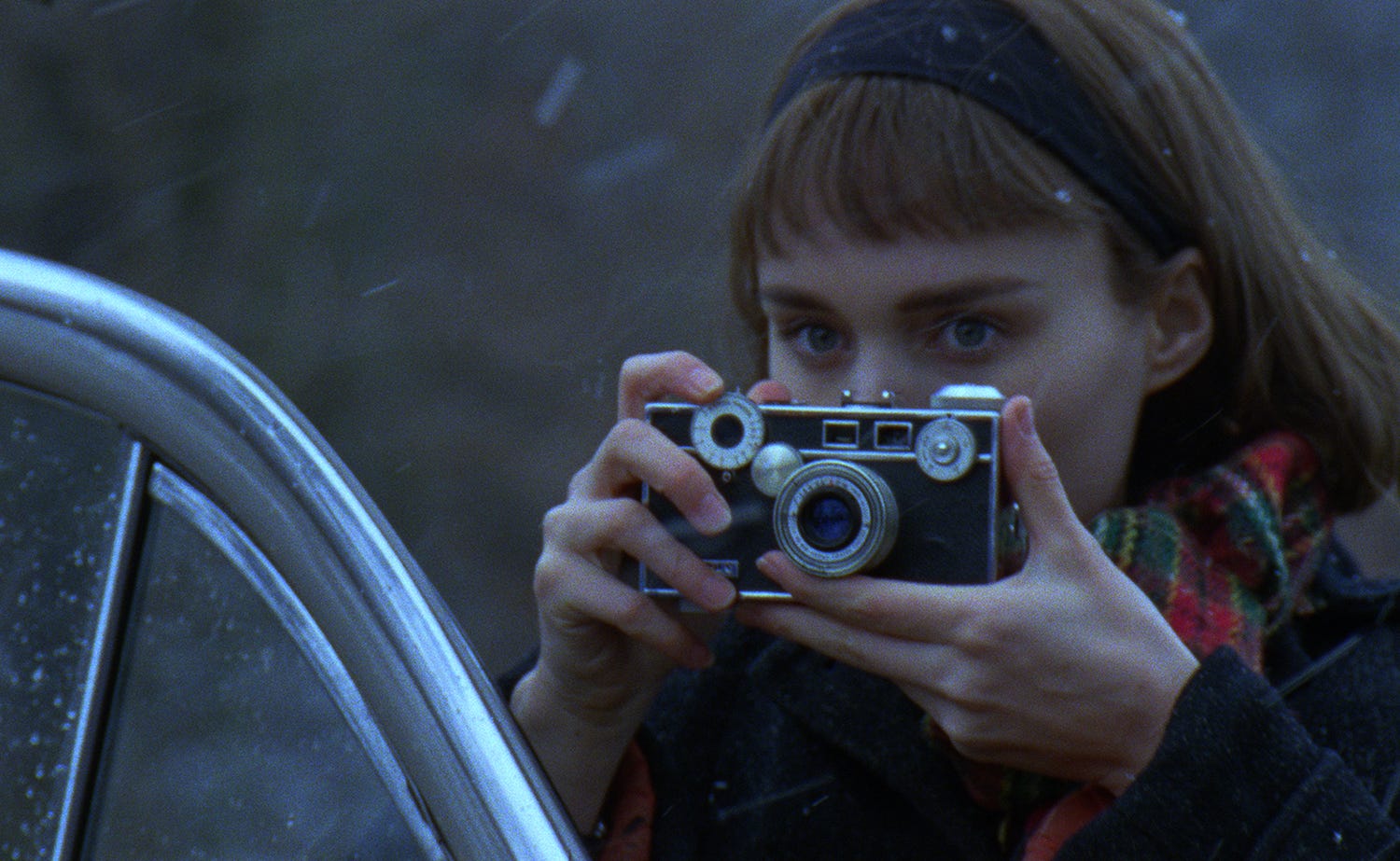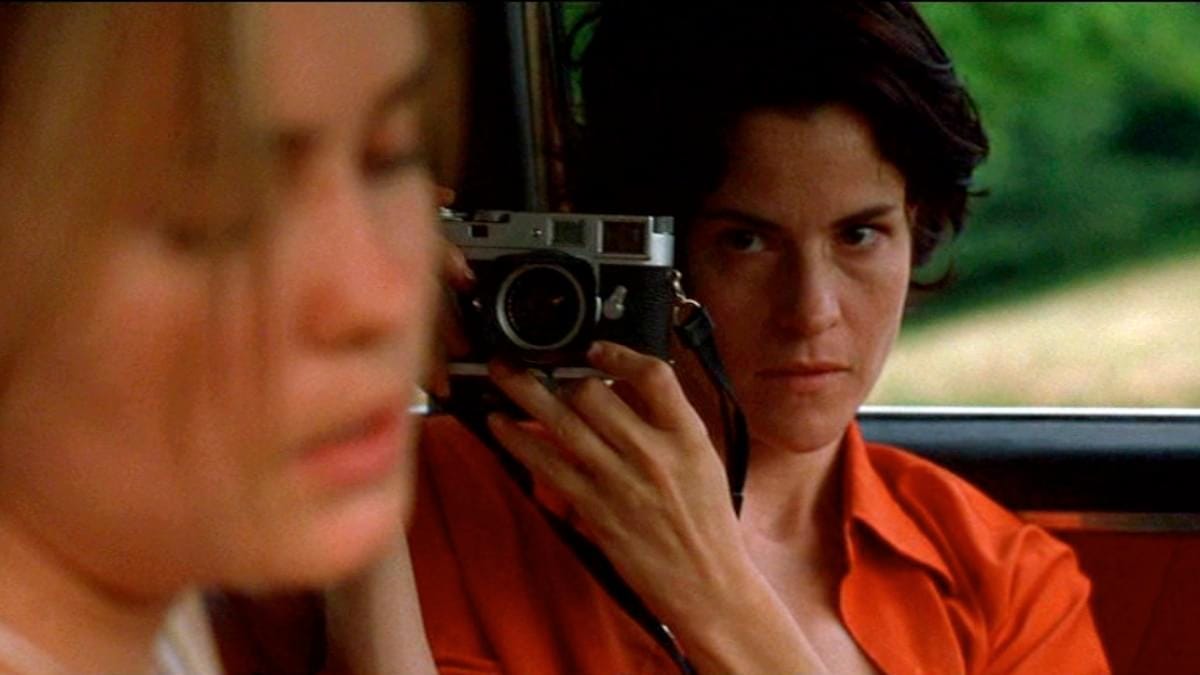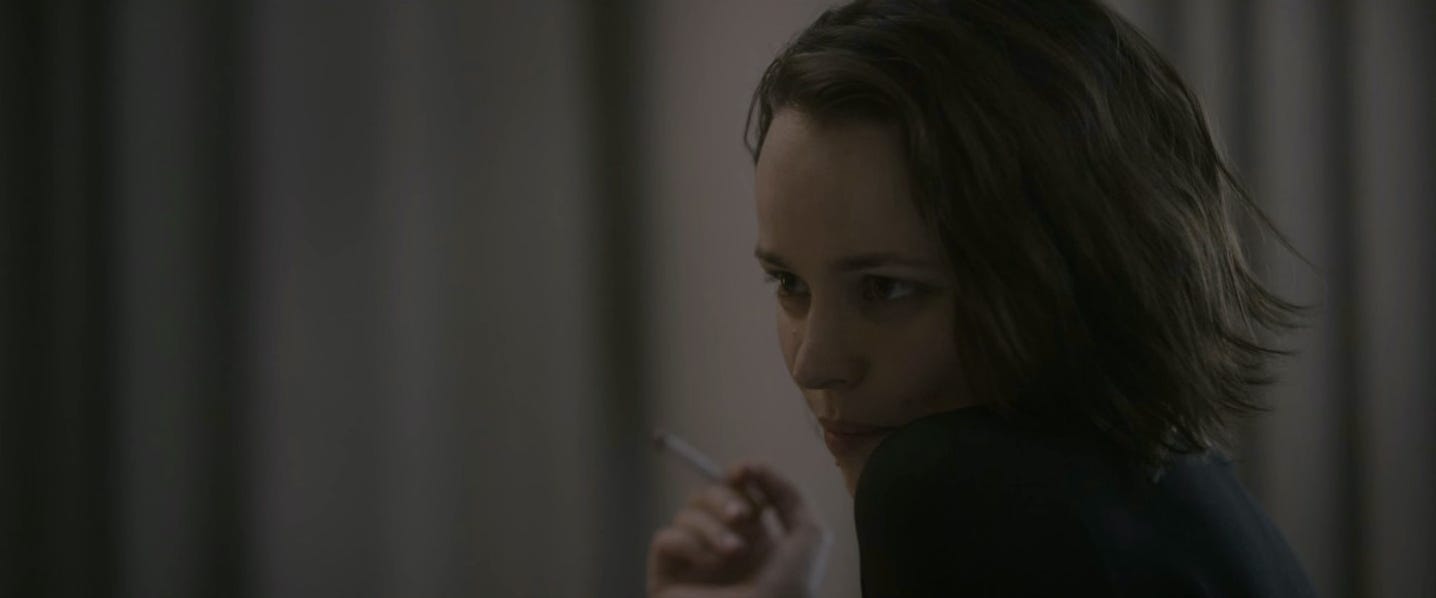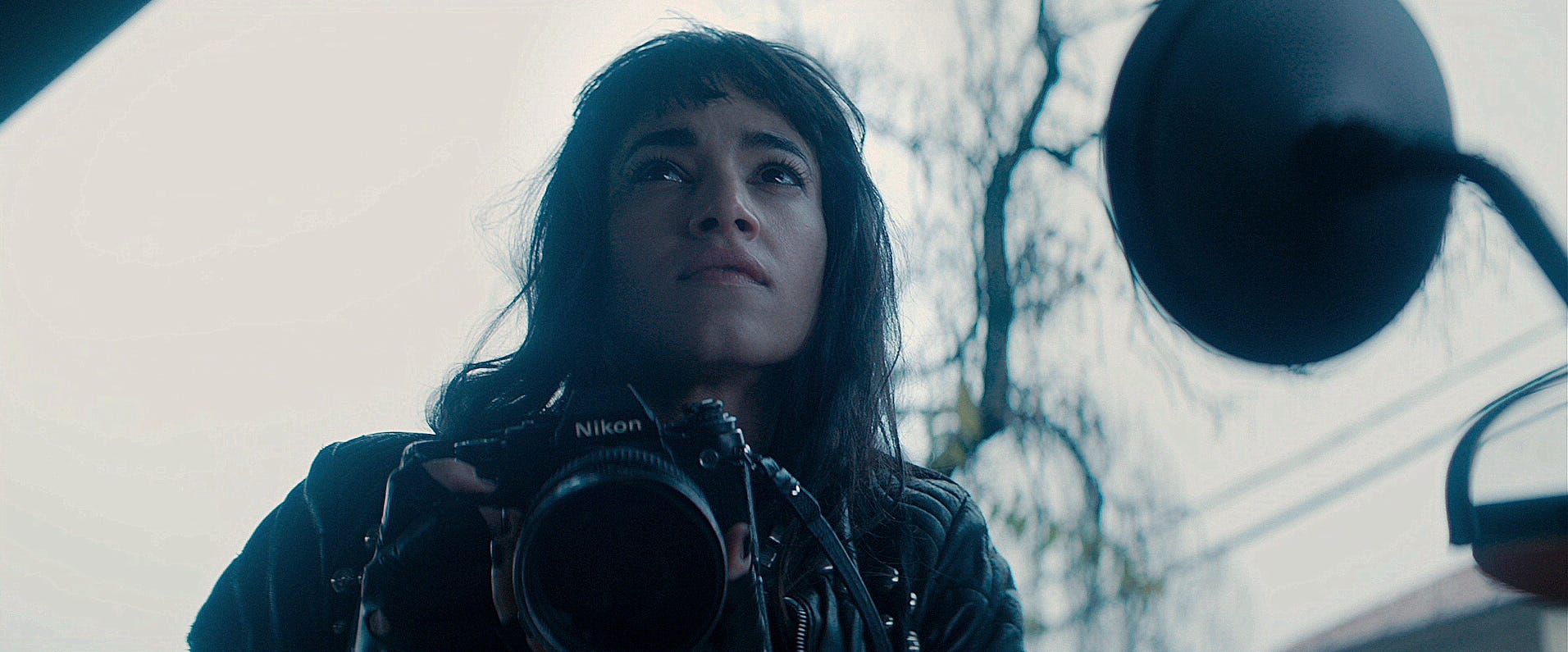Paging Dr. Lesbian - The Lesbian Behind The Camera
This is the Sunday Edition of Paging Dr. Lesbian. If you like this type of thing, subscribe, and share it with your friends. Upgrade your subscription for more, including weekly dispatches from the lesbian internet. I still have a special 60-day sale going on! Why do so many lesbian films depict women taking pictures of each other? It would be a stretch to call this a quantifiable trend, but there are several notable examples of this phenomenon in film and television. The most oft-cited of these is the film Carol, in which the protagonist, Therese (Rooney Mara), is an aspiring photographer who takes photographs of the object of her affection. Disobedience also features a lesbian photographer protagonist, Ronit, played by Rachel Weisz. Lisa Cholodenko’s 1998 film High Art actually features two women who work in the photography world. Radha Mitchell plays a young woman who works at a photography magazine, and her love interest is a renowned photographer named Lucy, played by Ally Sheedy. Lucy’s work is based on the photography of acclaimed portraitist Nan Goldin, who often captured members of the queer community in her photographs.¹ There are several other examples, including I’ve Heard The Mermaids Singing, a 1987 film that features a lesbian photographer protagonist, as well as the low-budget lesbian Christmas movie City of Trees. The Charlize Theron spy movie Atomic Blonde features sapphically-inclined photographic surveillance. Loving Annabelle and Aimee & Jaguar feature scenes of lesbian lovers taking pictures of one another as a means of preserving their romance. The 2018 film Snapshots uses photography to tell a secret lesbian love story from decades past. There’s also the Freeform series The Bold Type, whose lesbian character, Adena (Nikohl Boosheri) works as a photographer. As I already noted, a few examples don’t necessarily make a trend, but there seems to be something about photography as an artistic pursuit that lends itself to lesbian storytelling. So what’s with all these lesbians taking pictures of each other? The most obvious implication of this connection relates to the idea of the gaze. Photography allows for a penetrating yet invisible gaze that the lesbian character can use to interact with the world around them. As Maria Turner Carney writes, characters that are filmmakers or photographers “create a disembodied gaze that they utilize as an implement to capture their interests, and it becomes a fractured retelling of where their eye wanders.” Importantly, photography allows the lesbian character to capture her environment without being seen. The position of the camera creates a barrier between her and the “real” world that she’s capturing. The disembodied, removed nature of photography evocatively illustrates ideas about power and agency, themes that often get explored in lesbian films. The camera allows the lesbian photographer to control the scene around her as she momentarily embodies a sense of powerful omnipresence. Lesbians have historically been denied agency and the means to control their own lives. In lesbian romance films, these conditions are often primary plot points that result in barriers that make it difficult for our protagonists to be together. By quite literally objectifying what is in front of the camera, the photographer controls the scene in front of them, if only symbolically. Susan Sontag, a lesbian writer who was engaged in a years-long relationship with the most famous lesbian photographer of all time, Annie Leibovitz, writes extensively about the topic in her book On Photography. “To photograph is to appropriate the thing photographed. It means putting oneself into a certain relation to the world that feels like knowledge -- and, therefore, like power,” Sontag suggests. She argues that while photography may seem like a passive action, it is actually quite aggressive because of how it forcefully objectifies those caught in front of the lens. “It turns people into objects that can be symbolically possessed,” she writes. For the lesbian character in a state of dispossession or confinement, this “relation to the world,” as Sontag puts it, is potentially empowering. And indeed, the most thoughtful pieces of romantic art – such as Portrait of a Lady on Fire, which features painting rather than photography – trouble this predetermined relation between subject and object. Photography is inherently voyeuristic, and it is also primarily a solitary practice. Carol is most thoroughly a movie about loneliness, and Therese’s relationship to photography illustrates and is a function of her lonely state. She tells a friend that she only photographs objects and landscapes because people don’t really interest her. But when she meets Carol, she suddenly finds a subject she’s interested in. She begins by photographing Carol from a distance, as in the famous scene where Carol is picking out a Christmas tree, engaging with the object of her desire from a voyeuristic distance. Later, she takes a picture of Carol sitting right across from her in a booth, physically revealing her desire to be closer to her. In Atomic Blonde, the voyeuristic function of photography is much more overt. Delphine (Sofia Boutella) is a French spy who’s been tasked with surveillance Lorraine (Charlize Theron), an MI6 agent. Delphine doesn’t seem to be especially good at her job, but she does succeed in taking photos of Lorainne and eventually winds up in bed with her. The film takes place before the advent of digital photography and, as in Carol, we observe Delphine developing the photos of Lorainne privately, in a darkroom. There’s no way around the voyeuristic nature of such an action, whether it's undertaken for love or because of a direct order. The notion of voyeurism often has sexual undertones, and you don’t have to look hard for the erotic implications of photography within these films. In High Art, both characters find themselves the subject of the erotic gaze of the camera, and in many ways, photography becomes their language of desire. In Disobedience, the scene where Ronit (Weisz) takes photographs of Esti (Rachel McAdams) comes directly after their famous spit-laced sex scene. Though they have since gotten dressed and are no longer touching, the impromptu photography session feels like a continuation of their sexual encounter as the two women navigate intimacy and agency from behind and in front of the lens. Though Carol is probably the least erotic of the films we’ve discussed so far, photography still has an important function in regard to desire. Therese is unsure whether her desire for Carol is reciprocated, not to mention the fact that it was quite dangerous to express lesbian desire publicly in the 1950s. Thus, the camera acts as a conduit for Therese’s desire for Carol, allowing her to express her feelings in a relatively safe manner. The separation between public and private is a hugely important distinction in lesbian films, and the action of taking a photograph is one way this contrast can be emphasized. For obvious reasons, photography in public vs photography in private have quite different connotations. While long-distance, voyeuristic photography necessitates a distance between the photographer and their object, portrait photography engenders an intimacy between artist and muse. In intimate settings, photography can illustrate how vulnerable it feels to truly be seen. When Ronit asks Esti to turn around and pose for her, she’s initially hesitant. But her momentary shyness eventually transforms into confidence as she grabs the cigarette from Ronit’s hand and seductively smokes it. In Carol, the title character at times appears somewhat close-off and cold, and photography is actually one of the things that gets her to open up. Though they are not technically in private, the scene where Therese and Carol sit in a diner and Therese takes Carol’s picture engenders even more intimacy between the two women. Like Esti, Carol is initially uncomfortable with being photographed and holds her hands up in front of her face, saying “I look a fright.” But Therese’s insistence on capturing Carol as she really is – or at least how Therese sees her – is obviously a meaningful moment for Carol, who eventually acquiesces to the request. While Therese initially presents as the shy one and Carol as her more forward counterpart, Therese’s possession of a camera in some ways reverses their positions. While the framework of subject and object is always present during romantic encounters, lesbian narratives sometimes problematize this distinction because the expected heteronormative dynamic is not a given. Photography further draws attention to a dynamic that might otherwise remain unspoken. Not to overlook the obvious, the lesbian photographer character is also a very literal embodiment of what we might call the lesbian gaze, if such a thing can even be said to exist. All lesbian films must in some sense contend with the legacy of the male gaze, and the tool of photography offers a way to highlight how rare and powerful the lesbian perspective truly is. Moreover, the depiction of photography within filmmaking illustrates the distinction between visibility and invisibility, a discrepancy that has long defined the production (or lack thereof) of lesbian films. While photography captures a moment in time and makes it visible to others, the photographer herself often remains invisible. Seeing the world through the eyes of a lesbian is powerful, but so is seeing the woman behind the camera. By capturing both of these frames at once, these films visualize the questions that populate lesbian media more broadly. 1 If you want to learn more about Nan Goldin and the intersections between queerness, photography, and activism, you MUST check out the film All The Beauty And The Bloodshed, which is now streaming on HBO Max. You’re a free subscriber to Paging Dr. Lesbian. For the full experience, which includes weekly dispatches from the lesbian internet, become a paying subscriber. Your support means a lot! |
Older messages
The Ecstatic Joy of Queer Friendship
Sunday, April 9, 2023
Or, The Loving Lessons of Boygenius
10 Movies To Watch If You Love Carol
Sunday, April 2, 2023
On falling in love, out of time
'The Fifth Wound' Will Swallow You Whole
Sunday, March 26, 2023
On Aurora Mattia's startling debut
Discovering "Lianna"
Sunday, March 19, 2023
A hidden gem of independent '80s cinema
Ready Or Not, Here Comes Mama
Sunday, March 12, 2023
To Wong Foo is an unlikely '90s classic, but how does it resonate today?
You Might Also Like
6 Most Common Tax Myths, Debunked
Saturday, March 8, 2025
How to Finally Stick With a Fitness Habit. Avoid costly mistakes in the days and weeks leading up to April 15. Not displaying correctly? View this newsletter online. TODAY'S FEATURED STORY Six of
Weekend: My Partner Can’t Stand My Good Friend 😳
Saturday, March 8, 2025
— Check out what we Skimm'd for you today March 8, 2025 Subscribe Read in browser Header Image But first: this is your sign to throw away your old bras Update location or View forecast EDITOR'S
Your Body NEEDS to Cardio Row! Here Are Some Options.
Saturday, March 8, 2025
If you have trouble reading this message, view it in a browser. Men's Health The Check Out Welcome to The Check Out, our newsletter that gives you a deeper look at some of our editors' favorite
What Do You Really Need?
Saturday, March 8, 2025
Is opposing consumerism lacking gratitude? ͏ ͏ ͏ ͏ ͏ ͏ ͏ ͏ ͏ ͏ ͏ ͏ ͏ ͏ ͏ ͏ ͏ ͏ ͏ ͏ ͏ ͏ ͏ ͏ ͏ ͏ ͏ ͏ ͏ ͏ ͏ ͏ ͏ ͏ ͏ ͏ ͏ ͏ ͏ ͏ ͏ ͏ ͏ ͏ ͏ ͏ ͏ ͏ ͏ ͏ ͏ ͏ ͏ ͏ ͏ ͏ ͏ ͏ ͏ ͏ ͏ ͏ ͏ ͏ ͏ ͏ ͏ ͏ ͏ ͏ ͏ ͏ ͏ ͏ ͏ ͏ ͏ ͏ ͏
“Otway” by Phoebe Cary
Saturday, March 8, 2025
Poet, whose lays our memory still / Back from the past is bringing, ͏ ͏ ͏ ͏ ͏ ͏ ͏ ͏ ͏ ͏ ͏ ͏ ͏ ͏ ͏ ͏ ͏ ͏ ͏ ͏ ͏ ͏ ͏ ͏ ͏ ͏ ͏ ͏ ͏ ͏ ͏ ͏ ͏ ͏
Cameron Diaz Returned To Fashion Week In A Fabulous Little Red Dress
Saturday, March 8, 2025
WOW. The Zoe Report Daily The Zoe Report 3.7.2025 Cameron Diaz's Asymmetrical Red Dress Lit Up The Stella McCartney Fall 2025 Show (Celebrity) Cameron Diaz Returned To Fashion Week In A Fabulous
5-Bullet Friday — Breaking the Sperm Bank, D-Cycloserine, Tools for Grumpy Elbows, and Wisdom from Seth Godin
Saturday, March 8, 2025
“If you're feeling creative, do the errands tomorrow. If you're fit and healthy, take a day to go surfing. When inspiration strikes, write it down." ͏ ͏ ͏ ͏ ͏ ͏ ͏ ͏ ͏ ͏ ͏ ͏ ͏ ͏ ͏ ͏ ͏ ͏ ͏ ͏
Inside Alex Pereira's Training for Saturday's UFC 313 Showdown
Friday, March 7, 2025
View in Browser Men's Health SHOP MVP EXCLUSIVES SUBSCRIBE Inside Alex Pereira's Training for Saturday's UFC 313 Showdown Inside Alex Pereira's Training for Saturday's UFC 313
Update Your Android Devices Now 🚨
Friday, March 7, 2025
This TikTok Cleaning Method Might Have Broken My Fan. The security update includes fixes for two zero-day exploits. Not displaying correctly? View this newsletter online. TODAY'S FEATURED STORY
EmRata's Itty-Bitty Bikini Just Brought Back This "Cheugy" 2010s Trend
Friday, March 7, 2025
Plus, everything you need to know about Venus retrograde, your daily horoscope, and more. Mar. 7, 2025 Bustle Daily New books from Emily Henry, Karen Russell, and Kate Folk are among Bustle's best

